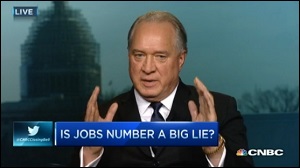By Pam and Russ Martens: August 10, 2015

Gallup CEO, Jim Clifton, Worries Aloud on CNBC That He Might Disappear for Criticizing the Government’s Job Numbers (February 4, 2015)
Last Friday’s nonfarm payrolls report of 215,000 new jobs in July with its attendant announcement of an unemployment rate of 5.3 percent drew mostly yawns from the media. That wasn’t the case on February 3 of this year when Jim Clifton, CEO of the polling company, Gallup, wrote a stunning opinion piece on the company’s web site calling the U.S. unemployment rate “The Big Lie.” Clifton raised more media frenzy the next day when he appeared on CNBC and suggested he might “disappear” for questioning the government’s unemployment rate.
Back then, the official unemployment rate was 5.6 percent. Today it’s 5.3 percent – a very healthy looking rate for an economy that is supposedly on the rebound.
One of the bogus aspects raised by Clifton in his opinion piece about how the U.S. government calculates the unemployment rate was this:
“Say you’re an out-of-work engineer or healthcare worker or construction worker or retail manager: If you perform a minimum of one hour of work in a week and are paid at least $20 — maybe someone pays you to mow their lawn — you’re not officially counted as unemployed in the much-reported 5.6%.”
Even for a government hell bent on putting the best possible spin on overcoming the Wall Street train wreck of 2008, which brought on the worst economic slump since the Great Depression, characterizing someone working one hour a week in a lawn job as “employed” seems like the height of duplicity. We decided to check it out.
We went directly to the source: the Bureau of Labor Statistics (BLS), the Federal agency that calculates who is employed and who is not. According to the BLS, the bogus nature of who is counted as “employed,” is even worse than Clifton suggests. Not only is a person counted as employed if they are working one hour a week in a lawn job paying $20, but a worker who makes no money at all donating his or her services to a family business for 15 hours or more per week is also considered employed.
Throughout the rest of America, one’s donation of services typically defines one as a volunteer not an employed worker; but the BLS doesn’t see it that way.
From the Bureau of Labor Statistics web site:
“People are considered employed if they did any work at all for pay or profit during the survey reference week…
“Garrett is 16 years old, and he has no job from which he receives any pay or profit. However, Garrett does help with the regular chores around his parents’ farm and spends about 20 hours each week doing so.
“Lisa spends most of her time taking care of her home and children, but she helps in her husband’s computer software business all day Friday and Saturday.
“Both Garrett and Lisa are considered employed. They fall into a group called unpaid family workers, which includes any person who worked without pay for 15 hours or more per week in a business or farm operated by a family member with whom they live. Unpaid family workers comprise a small proportion of total employment. Most of the employed are either wage and salary workers (paid employees) or self-employed (working in their own business, profession, or farm).”
The tricked up unemployment rate helps explain why the labor force participation rate is at a 38-year low of 62.6 percent. According to the BLS, July 2015 seasonally adjusted data show 93,770,000 individuals not in the labor force. That compares with 91,975,000 not in the labor force in July 2014. How can the economy and unemployment situation be improving when droves of workers are dropping out of the labor pool? Blaming the anomaly on retiring baby boomers does not explain what is happening to working age men and women.
In July 2014, there were 35.5 million men aged 16 and older not in the labor force. Today, that figure stands at 37.5 million not in the labor force, an increase of exactly 2 million men of working age. For women aged 16 and older, in the same span of time, their nonparticipation in the labor force has grown from 54.9 million individuals to 56.2 million.
The dismal labor force participation statistics are completely consistent with a tepid economy that can’t get out of the mire of 2 percent annual GDP growth, negligible wage growth, extended periods of unemployment (28 weeks versus the typical 16 weeks in the two decades prior to the 2008 crash), sluggish consumer demand, collapsing commodity prices and persistent warnings of the threat of global deflation.
The cold reality of the actual employment numbers is being molded and massaged daily by corporate media headlines pronouncing strong employment growth. Consider this morning’s headline at a Bloomberg Business interview with Stanley Fischer, Vice Chairman of the Federal Reserve: “U.S. Near Full Employment.”
Update: Labor force participation data for July 2014 has been updated to reflect the seasonally adjusted number.

